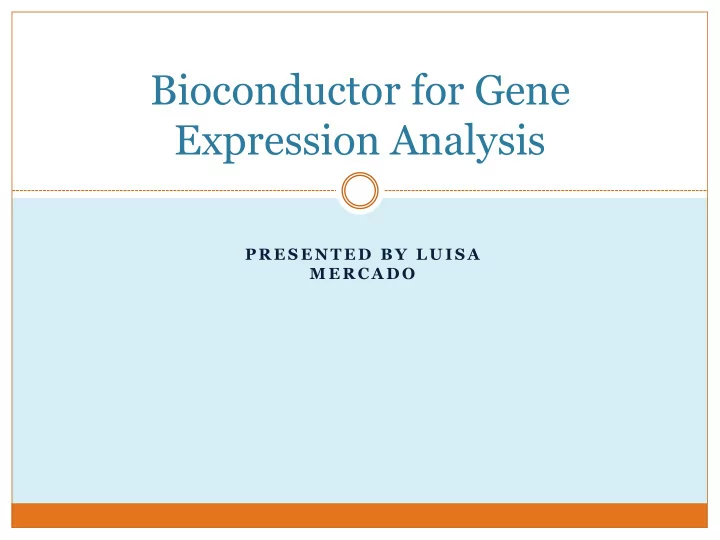

Bioconductor for Gene Expression Analysis P R E S E N T E D B Y L U I S A M E R C A D O
Presentation Roadmap What is Gene Expression Analysis? What is Bioconductor? The ALL dataset Example 1: Non-specific Filtering Example 2: Gene Selection Example 3: Multiple Testing Correction Summary
What is Gene Expression Analysis? Gene expression analysis consists on monitoring the expression levels of multiple genes simultaneously under a particular condition. Comparisons of the level of expression of the genes could be used to identify prognostic biomarkers, classify diseases or monitor the response to therapy.
What is Gene Expression Analysis? Gene expression data can be represented as a matrix of expression levels Source: www.google.com
What is Gene Expression Analysis? Gene expression analysis can be summarized into four stages: Data Processing/ Quality Control Differential Expression Clustering and Data Visualization Classification and Prediction
What is Bioconductor? Bioconductor is an open source and open development software for the analysis of genomic data. It uses the R programming language to design and distribute integrated and interoperable software modules, called packages to provide comprehensive software solutions to relevant problems.
What is Bioconductor? Source: Bioconductor.org
The ALL Dataset This dataset come from a study of acute lymphoblastic leukemia (ALL). It consists of microarrays from 128 different individuals with this type of disease. There are 95 samples with B-cell ALL and 33 with T-cell ALL, which refers to two different types of tumors among these samples. The B-cell ALL sample, contains information about individuals carrying the BCR/ABL mutation and individuals that do not display a cytogenetic abnormality. The total number of genes found in the B-cell ALL sample is 12,625.
Example 1: Non-specific Filtering Non-specific filtering is used to remove those genes that seen to be low or never expressed under any condition. The overall variability is calculated for each probe set regardless to which sample they belong to. Those genes with low variability are removed from the analysis assuming that gene expression is reflected as high variability. The rowSds and the shorth functions from the genefilter package can be used to perform this task.
Example 1: Non-specific Filtering
Example 2: Gene Selection Gene selection consists of selecting those genes that are differentially expressed between samples and therefore can be used to discriminate between them. A statistical test can be performed for each probe. The null hypothesis is that they are not differentially expressed. The function rowttests from the genefilter package can be used to perform this task.
Example 2: Gene Selection
Example 3: Multiple Testing Correction Multiple Testing Correction aims to reduce the rate of type I errors resulted from multiple statistical tests. The function mt.raw2adjp from the multtest package uses the Benjamini & Hochberg Procedure to control the False Discovery Rate (FDR).
Example 3: Multiple Testing Correction
Example 3: Multiple Testing Correction
Presentation Roadmap What is Gene Expression Analysis? What is Bioconductor? The ALL dataset Example 1: Non-specific Filtering Example 2: Gene Selection Example 3: Multiple Testing Correction Summary
Sources: Hahne, F., Wolfgang, H., Gentleman, R., & Falcon , S. (2008). Bioconductor Case Studies. Springer. Heydebrek, A. v., Wolfgang , H., & Gentleman, R. (2004). Differential Gene Expression with the Bioconductor Project. Bioconductor Working Papers. Hofmann, W.-K. (2006). Gene Expression Profiling by Microarrays. Cambridge University Press. McLachlan, G. J., Do, K. A., & Ambroise, C. (2004). Analyzing Microarray Gene Expression. John Wiley & Sons, Inc. . Tarca, A. L., Romero, R., & Draghici, S. (2006). Analysis of microarray experiments of gene expression profiling. National Institute of Health- Public Access, 373-388.
Recommend
More recommend